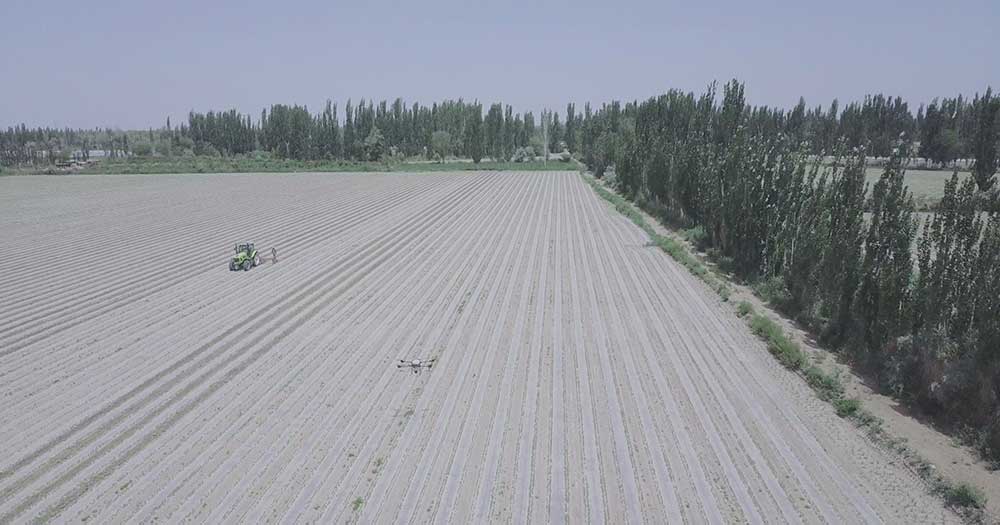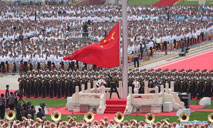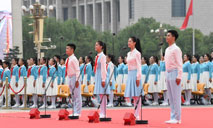Xinjiang’s indigo industry: a rising tech hub on the Belt and Road

The time-honored national treasure – "Five stars rise in the East" arm protector – draws crowds who come to admire its exquisiteness and profound meaning at Xinjiang Museum, Urumqi. (Photo/Global Times)
Among a display of satin brocades now worn with age, a 2,200-year-old silk arm protector lies quietly in a dusky glass case in Xinjiang Museum. It is a dapple of indigo and gold, with eight Chinese characters woven in perfect harmony. Literally meaning “Five stars rise in the East, benefitting China,” the brocade is a time-honored national treasure and strong evidence of how advanced technologies ensured Xinjiang’s critical position along the ancient Silk Road.
The silk work, unearthed in 1995 from a tomb of the Nita Ruins in Xinjiang, is a masterpiece showcasing the world’s most advanced textile technologies from millennia ago. While Pliny the Elder (AD23 – 79), the famous Roman naturalist, stubbornly believed that silk from China was a product of certain trees, his contemporary counterparts in Xinjiang had already built complex machines producing the world’s finest silk, raising the curtain on one of the largest international trade routes in human history - the ancient Silk Road.
Millennia later, technologies have once again made Xinjiang a major tech hub along the Belt and Road. Over vast cotton fields, drones accelerate their way through thick clusters of cotton spraying insecticide, while in modern factories, 45 percent of the world’s polysilicon, a type of upstream raw material in the photovoltaic (PV) industry, is refined and produced.
“Advanced technologies benefited Xinjiang in ancient times. Today, with the help of modern science and innovation, surely the auspicious sign of ‘Five stars rise in the East’ will happen again, leading Xinjiang to a brighter future,” said Anwar Abdukerim, vice director and historian at Xinjiang Museum.
Rise of a tech hub

A view of Xinjiang Daqo. (Photo/People's Daily Online)
Unlike ancient silk, Xinjiang’s modern tech innovation started from something much more inconspicuous – polysilicon. This indigo raw material is essential for the PV industry, which requires advanced technologies to refine and produce.
“Before 2010, the polysilicon used in global solar energy had been monopolized mainly by companies from the US and Germany. Prices could go up to 500 US dollars per kilogram, and that’s why we’ve decided to ramp up efforts to develop our own polysilicon production,” said Cao Wei, manager of Xinjiang Daqo, one of the four major Chinese polysilicon manufacturers.
Established in 2010 in Shihezi, Xinjiang, it took Xinjiang Daqo a decade to become a world leading polysilicon manufacturer. After years of intensive research and experiment, the company’s polysilicon production accounted for 15 percent of the global market share in 2020.
According to Cao, production of polysilicon requires intensive energy, and Xinjiang, a region with abundant cheap electricity and thermal power, is the ideal place for developing the PV industry.
“Thanks to technological innovation, the price of polysilicon has now dropped to 20 dollars per kilogram, paving the road for the development of China’s PV industry,” said Cao.
After years of development, China is now a leading power in the PV industry. According to Global Times, Chinese raw material of silicon now accounts for 67 percent of the global share, wafers 97 percent, solar cells 79 percent and PV modules 71 percent, most of which are produced in Xinjiang.
The development of polysilicon production is just one example of Xinjiang’s modern tech innovation. As of 2020, Xinjiang has 791 high-tech enterprises, 19 high-tech development zones and over 25,000 research and development (R&D) professionals, covering a wide range of high-tech sectors including robots, navigation satellite systems and electronic products.

A drone works in the cotton field in Korla, northwest China's Xinjiang Uygur Autonomous Region.(People's Daily Online/Liu Ning)
Monitoring the giant screens at the Xinjiang Software Park in Urumqi, scientists send orders to drones and tractors to plot the cotton fields in Aksu Prefecture 1,000 kilometers away. By using the Beidou Navigation Satellite System, 5,954 tractors and over 5,000 drones are now working automatically in fields across Xinjiang, and the number continues to grow.
Established in 2017, Xinjiang Tianyu Beidou satellite Technology Co., Ltd. is a leading satellite navigation and 5G network company. Having built 129 Beidou base stations across Xinjiang, the company now offers a wide range of navigation services, including intelligent agriculture and grazing.
In Bohu county of Bayingol Mongolian Autonomous Prefecture in Xinjiang, more than 1,000 humped camels have been fitted with Beidou satellite navigation collars, allowing herdsmen to remotely track the location and speed of a camel herd in real time using a mobile phone.
“Our system can locate animals by attaching a chip to their ears, allowing herdsmen to check their animals with a simple click on their mobile phone. They can also make use of the pedometer and temperature monitoring functions to check the health of their animals,” said Chen Hu, designer and director of the company.
According to Chen, camel herders usually live with their camels in the Gobi Desert, and when their animals get lost, finding them again is painstaking and difficult. With the navigation system, the herdsmen can now graze their animals remotely without leaving their homes, giving them more time to cultivate plots of land to earn an extra income.
“Each chip only costs 300 yuan and is charged by mini-solar panels. You only have to attach one chip to the bellwether and the whole herd can be supervised. Such technologies have been welcomed by many nations along the Belt and Road, especially Kyrgyzstan and Kazakhstan, where herdsmen can easily lose track of their animals in the vast mountain areas,” said Chen.
Xinjiang’s booming technological development has earned the region a lucrative income. In 2019, mechanical and electrical products were the most popular exported goods in Xinjiang, with an export value hitting 33.79 billion yuan, accounting for 27 percent of the region’s total exports. The electronic industry has now been labeled as one of the ten economic pillars of Xinjiang in the region’s 14th five-year plan.
“Scientific research and technologies have boosted Xinjiang’s economic growth and development. Our software park now attracts talents across China to start their business and research. In time, Xinjiang will rise as a major tech hub along the Belt and Road,” said Wang Xiaogang, director of the Xinjiang Software Park.
Benefiting from technology

Thanks to modern technologies, Li Nana is now in charge of a six-hectare cotton field. (People's Daily Online/Kou Jie)
It was June, and the city of Shihezi smelled of scorched leaves, with an average daytime temperature of 35℃. The sunshine was like powered gold shining over 38-year-old Li Nana’s vast cotton field, while Li, sheltered from the blazing sun under a tree, watched a drone spray insecticide on her cotton seedlings.
“Thanks to modern technologies, I only need to work in the field around 40 days every year, and for less than 5 hours each day. I myself am in charge of over 6 hectares of cotton field. Basically, everything is now done by machines,” said Li.
According to Li, before machines were used in cotton fields in Xinjiang, even the most skilled cotton farmer could only take care of a field of less than 3 hectares, and he would have to spend at least 7 hours a day taking care of the cotton.
“Thanks to modern technologies, I can now take care of my family’s cotton fields by myself. Each hectare of cotton field can earn me over 20,000 yuan, while my husband is now working in a local factory to earn extra income,” said Li.
As China's largest cotton-producing area, Xinjiang saw cotton output of more than 5.1 million tons in 2020. Nearly 70 percent of the region's 1.6 million hectares of cotton farmland was harvested by machinery rather than by hand thanks to continuous progress in agricultural technology.

Ershat Ibrahim introduces Hotan rose tea to his clients online. (People's Daily Online/Kou Jie)
1,600 kilometers away from Li’s cotton field, 30-year-old Ershat Ibrahim is busy introducing Holtan rose tea to his clients online. As a social media influencer, Ibrahim’s online shop features Hotan's agricultural products, and he is also a content maker who make videos about local markets, agricultural festivals and local art.
Every week, Ershat invites his two partners, a pair of top Uyghur dancers, to livestream Uyghur dance to the audience, helping them to get a better understanding of Uyghur culture.
Working as a social media influencer, Ibrahim’s monthly income has reached 20,000 to 30,000 yuan per month, and he believes that the digital economy in Xinjiang will further develop, providing a bright future for all.
“There are still many remote villages in Xinjiang, where the residents still face poverty and all kinds of inconveniences in life. The best way to solve their problems is to introduce their life to the outside world via the internet, giving them new opportunities for a better life,” said Ibrahim.
According to statistics from the regional government’s department of industry and information technologies, the digital economy in Xinjiang registered a 10-percent growth year-on-year in 2020, contributing 26 percent to the region’s annual gross domestic product. Currently, 6,272 5G base stations are operating, with 2.75 million 5G users.
"The internet has provided young people like me a big platform to show our talents, and also introduced Uyghur culture to the public. It's interesting to see the dynamic integration between old and new, tradition and innovation," he said.
Photos
Related Stories
Copyright © 2021 People's Daily Online. All Rights Reserved.










